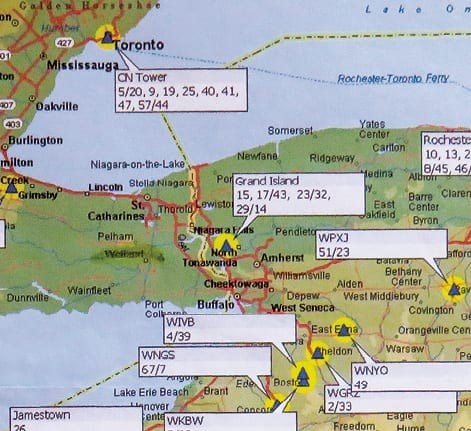It's back to the future with TV antennas
BY JOHN CHICK Special to the VOICE
Sick of paying high cable or satellite bills? Do you miss a simpler time when Irv Weinstein and Commander Tom Jolls beamed television into your wood-framed, radiation- emitting TV set the size of a chest freezer? We can’t help you with the latter, but with cord-cutting becoming more and more commonplace, over-the-air antenna television is making a comeback.
Some personal disclosure: When I first moved to Fonthill as a child with my folks, my father refused to pay for cable for several years. His logic was that being on a high point of land, an antenna—in those days, still complete with “rabbit ears” —would pick up stations from the sides of both lakes, in Toronto and Buffalo.
He was right—even if one unintended consequence was fandom of the Buffalo Bills—and some 30 years later, the logistics are still correct.
 “Those living in Niagara have a unique situation,” says Tyler Thomas, operations manager at Thomas TV, in Welland. “We live within 75 kilometres of TV broadcast towers in Canada and the U.S. Atop the CN Tower, antennas beam out free over-the-air signals from all Canadian networks—CBC, CTV, and Global. And from high-power antennas in the Buffalo area, the U.S. networks—NBC, CBS, ABC, FOX and PBS, plus many substations and independent channels.”
“Those living in Niagara have a unique situation,” says Tyler Thomas, operations manager at Thomas TV, in Welland. “We live within 75 kilometres of TV broadcast towers in Canada and the U.S. Atop the CN Tower, antennas beam out free over-the-air signals from all Canadian networks—CBC, CTV, and Global. And from high-power antennas in the Buffalo area, the U.S. networks—NBC, CBS, ABC, FOX and PBS, plus many substations and independent channels.”
Some significant aspects have changed over the years, however. In 2009, the U.S. Federal Communications Commission mandated over-the-air broadcast TV stations switch from analog to digital. Two years later, Canadian regulators did the same. Since then, the higher-quality digital signals—combined with HD and advances in antenna technology—have made over-the-air TV more relevant than any time since before the dawn of cable and satellite TV in the 1970s. The continuing rise of cable TV prices, without any real movement by carriers on promises to offer more a la carte channel choice, is only pushing it along.
Thomas also confirms a belief out there that antenna HD provides a clearer picture than cable or satellite-provider HD.
“It is much better, mainly because [the signal] is uncompressed,” he said.
Still, there are some downsides. Weaning oneself off of pay TV will find casualties in terms of certain specialty programs like sports. While most NFL and some NHL games broadcast on over-the-air networks like CBS, FOX, and CBC, local broadcast rights to teams like the Toronto Raptors and Blue Jays are exclusively the domain of cable sports networks such as TSN and Sportsnet — mainly because those channels are also owned by the teams’ media conglomerate owners in Bell and Rogers. As a result, those networks are not available via antenna. (It should be noted that Rogers also owns Canadian national NHL TV rights, but airs many games on traditional broadcast stations such as CBC Toronto’s channel 5 and CityTV).
Premium movie and episodic drama channels, such as HBO, are similarly unavailable.
“Unfortunately, cable-only channels are not licensed to broadcast over the air,” Thomas said. “So no ESPN, Food Network or National Geographic and the like.”
Also not in the cards is the ability to time-shift, or record live programs and watch them later, which is arguably the strongest reason to continue to pay through the nose for cable or satellite TV.

So in other words, making the switch makes more sense if you’re not a die-hard fan of multiple sports or certain niche programming, and can watch your shows live.
You can, however, supplement what you get via the antenna with streaming services such as Netflix, Amazon Prime, and a host of other, smaller content providers through devices such as Apple TV—a small decoding box, in effect. Just connect these devices to your TV with an HDMI cable, while attaching the antenna through either another HDMI port or coaxial jack.
There are two types of digital antennas: The simplest devices can sit on or near your TV and retail anywhere from $20 on up. These depend on your home already being at a relatively high elevation. Digital signals travel by line-of-sight, meaning if you live at the bottom of Effingham, well, you’re Effinghammed. Anywhere along the top of Escarpment, or not far from Highway 20, on the other hand, is likely to net far more channels.
For more powerful antennas that capture more channels and provide the most optimum signal, Thomas recommends an outdoor tower antenna, which he says requires fairly minimal installation.
“The hardware needed is very inexpensive when compared to the endless monthly cable charges,” he says. “For around a hundred dollars one can purchase a quite inconspicuous antenna that has an amplifier built in to increase its range that will pick up at least 20 channels. If you are a DIY person you can put this in the attic or on a satellite J-arm or some other mount, and run a wire to your TV. For a few hundred more dollars you can have a professional installer do this for you—40 to 50 stations are available in the central Niagara Peninsula with a larger antenna assembly that runs around $400. Installation is a little more involved, you may even want to mount this on a tower for $600 more, still less than one year's cable bill for most.”
Thomas says if you want a top-notch outdoor assembly, ask yourself these questions first:
What programs are you most interested in receiving? Do they originate from locations in Canada and/or the U.S.?
Are there any obstacles such as large buildings or hills that would restrict the signal from reaching you?
How will you physically mount an antenna on your home? Perhaps on the roof, on the chimney, on a tower or even inside your attic.
A visitor to Thomas TV’s showroom finds an array of antenna choices, with two or three in particular that Tyler Thomas says are particularly suited to the local terrain—though maybe not the depths of Effingham.
The bottom line: There are ways to escape Big Cable’s monopoly.


